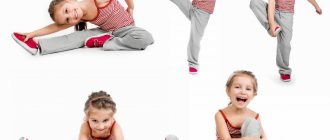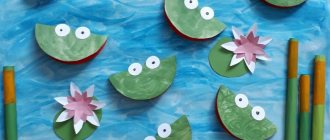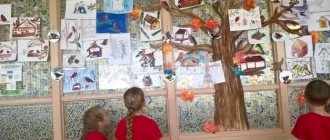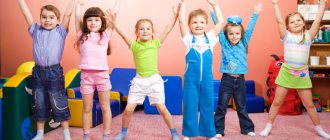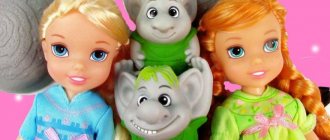A set of exercises for physical education minutes
SET OF EXERCISES FOR PHYSICAL ACTIVITIES
Exercises to improve cerebral circulation
1. Starting position (i.p.) – sitting on a chair, 1 – tilt your head to the right, 2 – i. n., 3 – tilt your head to the left, 4 – i. p., 5 - tilt your head forward, do not raise your shoulders, 6 - i. p. Repeat 3-4 times. The pace is slow.
2. I. p. - sitting, hands on the belt, 1 - turn the head to the right, 2 - i. n., 3 – turn the head to the left, 4 – i. p. Repeat 4-5 times. The pace is slow.
Exercises to relieve fatigue from the shoulder girdle and arms
1. I. p. - standing, hands on the belt. 1 – right hand forward, left up, 2 – change the position of the hands. Repeat 3-4 times, then relax down and shake your hands, tilt your head forward. Then repeat 3-4 more times. The pace is average.
2. I. p. - standing or sitting, with the back of the hands on the belt. 1-2 – bring your elbows forward, tilt your head forward, 3-4 – elbows back, bend over. Repeat 5-6 times, then hands down and shake relaxed. The pace is slow.
3. I. p. - sitting, hands up. 1 – clench your hands into a fist, 2 – unclench your hands. Repeat 6-8 times, then relax your arms down and shake your hands. The pace is average.
Exercises to relieve tension in the trunk muscles
1. I. p. - stand with legs apart, hands behind the head. 1-5 – circular movements of the pelvis in one direction, 4-6 – the same in the other direction, 7-8 – down and shake your hands in a relaxed manner. Repeat 4-6 times. The pace is average.
2. I. p. - stand with legs apart. 1-2 – tilt to the side, the right hand slides down along the leg, the left hand, bending, moves up along the body, 3-4 – and. p., 5-8 - the same in the other direction. Repeat 5-6 times. The pace is average.
A COMPLEX OF EXERCISES FOR PHYSICAL EDUCATION IN JUNIOR CLASSES IN LESSONS WITH ELEMENTS OF WRITING
Exercise to improve cerebral circulation
I. p. - sitting, hands on the belt. 1 – turn the head to the right, 2 – i. n., 3 – turn the head to the left, 4 – i. p., 5 – tilt your head forward, 6 – i. n. Repeat 4-6 times. The pace is slow.
Exercise to relieve fatigue from the trunk muscles
I. p. – stand with legs apart, hands on the belt. 1 – turn the body to the right, 2 – turn the body to the left. During the turn, the legs remain motionless. Repeat 4-6 times. The pace is average.
Exercise to relieve fatigue from small muscles of the hand
I. p. - sitting, arms raised up. 1 – clench your hands into a fist, 2 – unclench your hands. Repeat 6-8 times, then relax your arms down and shake your hands. The pace is average.
Exercise to mobilize attention
I. p. - standing, arms along the body. 1 - right hand on the belt, 2 - left hand on the belt, 3 - right hand on the shoulder, 4 - left hand on the shoulder, 5 - right hand up, 6 - left hand up, 7-8 - clapping hands above the head, 9 – lower your left hand on your shoulder, 10 – right hand on your shoulder, 11 – left hand on your belt, 12 – right hand on your belt, 13-14 – clap your hands on your hips. Repeat 4-6 times. Tempo – 1 time slow, 2-3 times – medium, 3-4 – fast, 1-2 – slow.
Get text
Thematic physical exercises in elementary school lessons
Thematic physical education lessons in elementary school lessons
Primary school teacher Liliya Ivanovna Dudina
The purpose of physical exercises is to actively change the children’s activities, ease the onset of fatigue, and then switch the child back to continuing classes. Main tasks: 1) relieve fatigue and tension; 2) add an emotional charge; 3) improve gross motor skills; 4) develop clear coordinated actions in relation to speech; 5) training speed skills and performing mental operations. In my work with children, I use health-saving technologies, among which I especially highlight thematic physical exercises. I believe that this material will be useful to any teacher going to a lesson in primary school.
1. Physical exercises in the lessons of the surrounding world
“Where are there a lot of vitamins?” Children stand in a circle. I throw the ball to any student, naming the product. If this product contains a lot of vitamins, then the student catches the ball, and the rest clap their hands. If there are no vitamins in the product, they throw it away and everyone stamps their feet. “Herbs, shrubs, trees” I name various plants. With a full squat, children show grass, stand at full height - bushes, hands up - trees. “We’ll play Traffic Light” One, two, three, four, five! Oh, we're tired of writing. (Stretching.) We will play “Traffic Light”, (Walking in place.) Stretch our arms and legs. (Shaking arms. Shaking legs.) Red light for us “Stop!” - shouts, orders to wait for green. So that the wait won't be boring, we bend down together. And back. And forward. (Tilts.) Left, right turn. (Turns the torso.) Now the yellow light is on, it’s time to get ready. Let's warm up our arms and legs, (Jerks with arms in front of the chest.) Let's start, kids! (Walking in place.) We’ll lift it up, we’ll lower it down, we’ll fly like an airplane. (Jumping.) When the green light turns on, we can go forward. Left, right, Left, right, (Running with a high hip lift.) We boldly move forward. (Walking in place.) The traffic light is a glorious assistant. It doesn’t let us get tired. In a lesson on the topic “How a plant develops,” you can play the game “How a plant grew”: I invite the children to imagine that they are small seeds falling into the soil (children squat down, squeezing into a ball). Next I tell you how a plant develops from a seed. — The little seed in the soil was cold in winter, it squeezed to keep warm (muscle tension, eyes closed). In spring, the sun's rays warmed the earth and the seed warmed up and straightened its shoulders (muscle relaxation). He became so interested in what was up there that it slowly began to grow. It has roots (children rise to their feet, open their eyes) and first leaves (raise their arms above their heads, bent at the elbows). The sun warmed the sprout that emerged from the seed so much that it decided to become tall and tall in order to wave its leaves to the sun (children stretch up, rise on tiptoe, wave their hands). And then one day a flower bloomed on a sprout, it smiled at the sun and other flowers (children smile at the teacher and each other, turning from side to side). And then autumn came and in place of the flower, seeds formed, which the plant dropped into the soil (hand movements, as if shaking off water, are aimed at relieving accumulated muscle tension). This is how the plant grew for a whole year.
2. Physical exercises in mathematics lessons
During math lessons in the first grade I play the game “The sea is agitated...”, then I show a fish with an example and name the answer. If it is correct, then the children clap, if not, then they stomp. The text is read before the exercises begin. – We count to five, we squeeze the weights, (i.p. - standing, legs slightly apart, raise your arms slowly up to the sides, fingers clenched into a fist (4-5 times)) – How many times will I hit the tambourine, How many times will we chop the wood , (i.p. - standing, feet shoulder-width apart, hands clasped upward, sharp bends forward - down) - How many green Christmas trees, how many bends we will perform, (i.p. - standing, legs apart, hands on the belt. Bends are performed ) - We squat as many times as we have butterflies (i.p. - standing, legs slightly apart. During squats, arms forward) - Stand on tiptoes, reach the ceiling (i.p. - main stance, hands on the belt. Rising to socks, arms up - to the sides, stretch) - How many lines to the point, How many times will we stand on our toes (4-5 times), (i.p. - the main stance. When lifting on your toes, arms to the sides - up, palms below shoulder level ) - We will count, collect mushrooms (i.p. - standing, feet shoulder-width apart. Bend forward (imitation of mushroom picking) - How many circles will I show, How many jumps will you perform (5 x 3 times), (i.e. p. - standing, hands on the belt, jumping on the toes) - We count the berries, squat together, (p. - basic stance, hands on the belt. Don’t lower your head, straight back) We clap our hands seven times, eight times with our feet let's stomp. Add three to seven - That's how much we have to sit down. (7 claps, stomp each foot 4 times, 10 squats.) Draw a triangle with your eyes. Now turn it upside down. And again, use your eyes to guide the perimeter. Draw a figure eight vertically. Don’t turn your head, but only carefully follow the lines of the water with your eyes. And put it on the side. Now follow horizontally, and stop in the center. Close your eyes tightly, don't be lazy. We finally open our eyes. Charging has ended. Well done! (Children imagine the appearance of geometric shapes.)
3. Physical exercises in writing and Russian language lessons
In the first grade, in order for children to quickly remember capital letters, I use the “Guess the Letter” minute: one child stands with his back to everyone and writes a capital letter in the air with a magic wand, and the rest guess.
The presenter changes with the one who guessed right. I throw minutes with a ball, call the word children - divide it into syllables, name synonyms, antonyms, put emphasis. “Soft separating sign” If you hear a soft separating sign in a word, you will sit down, if there is none, you will jump. “Soft sign” Do you run, hurry, eat, do you remember the soft sign? “Nouns” If you hear masculine nouns, you need to clap, if you hear feminine ones, you need to jump, if you hear the middle gender, you need to spread your arms. “Adjective name” Try to show the signs of objects with movements, facial expressions, gestures: big, hot, narrow, cheerful, tall, small, etc. “Phraseological menagerie” What names of animals can be added to the following phrases? Children name animals and use pantomime or facial expressions to depict them. Hungry like... (a wolf). Cunning like ... (fox). Cowardly as... (hare). Inflated like... (turkey). Clumsy like... (a bear). Stubborn as ... (donkey). Healthy as... (bull). Prickly, like... (hedgehog). If a vowel letter raises doubts, do not slowly put it under stress. I YOU, HE, SHE are a friendly family together. Together we learn to read, together we learn to write. And of course, and of course - to distinguish a sound from a letter. One, two, one, two - you can’t write a sound for us. We pronounce the sound, hear it, and write the letters in the notebook. Consist of letters of the word. He knows it, you, me. One, two, three, four, five - We all need to know clearly. We read, write, pronounce and hear sounds. Distinguish a sound from a letter And get an A. One, two, three, four, five - We all need to know this. The combination of ZHI and SHI We write only with the letter I. Thicket, grove - here CHA- SHCHA Is friends only with the letter A. I drag and drag the pike, And with happiness I shout to everyone - CHU and SHCHU, CHU and SHCHU Write everything with the letter U. ( When pronouncing the words of physical exercises, children repeat the movements after the teacher) Remember once and for all, That the vowels E, E, Y, I, At the beginning of the word, as always, indicate two sounds. There are four letters in the word TREE, but if you count the sounds, then, of course, there are not four of them. And in the FIR-tree there will be five sounds. And if in a word after the vowel there are E, Yo, Yu, Ya. Then in each such letter there will be not one sound, but two. You need to write it together. “Parts of a word” The text is written on the board. Before performing physical exercises, you need to restore the text by inserting the necessary prefixes. Dear children need to _become, Hands slowly _to. Fingers _press, then _press, So stand for a second. Release your hand smoothly. Repeat again With at – with the prefix, sit down, With with – with the prefix, rise, With under – jump, wink, With with – with the prefix, laugh. We stretch out our arms. S o - let's lower them again. That's all. The time has come to complete the exercise. Effective implementation of preventive and health-improving technologies with students at school is possible only with the purposeful, systematic activities of the teacher. And in the end I would like to remember the words of K.D. Ushinsky: “Give the child a little movement, and he will reward you again with ten minutes of live attention, and ten minutes of live attention, when you were able to use them, will give you more than a whole week of half-asleep activities.” »
We recommend watching:
A set of relaxation minutes for elementary school. Space physical education minutes for children 5-6 years old. Physical exercises for younger schoolchildren. Animated physical exercises for the eyes in the PoverPoint program step by step with photos.
Similar articles:
Gymnastics for the eyes. Exercises for children
Report “Physical education in preschool educational institutions and its significance”
Physical education in preschool educational institutions and its significance
Recently, health-saving technologies have been increasingly used in kindergartens. One of the directions of these technologies is the use in preschool institutions of methods to activate muscle tone and motor-coordinating systems. Physical education, as a form of active recreation during sedentary activities, is widely used with preschool children.
Physical education is physical exercise aimed at restoring children’s performance, improving their well-being, increasing attention, preventing fatigue, posture disorders, i.e. to improve the health of children's bodies. Complexes are exercises composed of different movements aimed at actively working various muscle groups and relaxing them; activation of attention, increased excitability of the nervous system, formation and strengthening of posture, as well as breathing. In addition to physical exercises, the complexes may include elements of massage, finger and breathing exercises, and eye exercises.
The purpose of a physical education session (dynamic pause) is to increase or maintain mental performance during direct educational activities, prevent fatigue, and provide short-term active rest for children when the organs of vision and hearing experience significant stress; muscles of the trunk, especially the back, which are in a static state; muscles of the working hand.
Physical education allows educators and teachers, as well as parents, to play with children, make them happy and, at the same time, develop speech, coordination and fine motor skills. In the process of performing physical exercises, blood circulation improves, areas of the cerebral cortex that were not involved in previous activity are excited, and those that did are inhibited. In this regard, fatigue of the muscles and nervous system is relieved, and children experience positive emotions and improve their mood.
Raising children to be physically perfect means ensuring that they are healthy and hardened from an early age.
To solve problems and improve the health of preschool children, various means of physical education are used, including physical education sessions. The integrated use of all means (hygienic factors, natural forces, physical exercise and others) effectively affects the child’s body.
Physical education is a small set of physical exercises performed for 2-3 minutes during classes in kindergarten, as well as at home when doing homework. It is built from 4-5 exercises for the arms, torso, and legs that do not require complex coordination.
